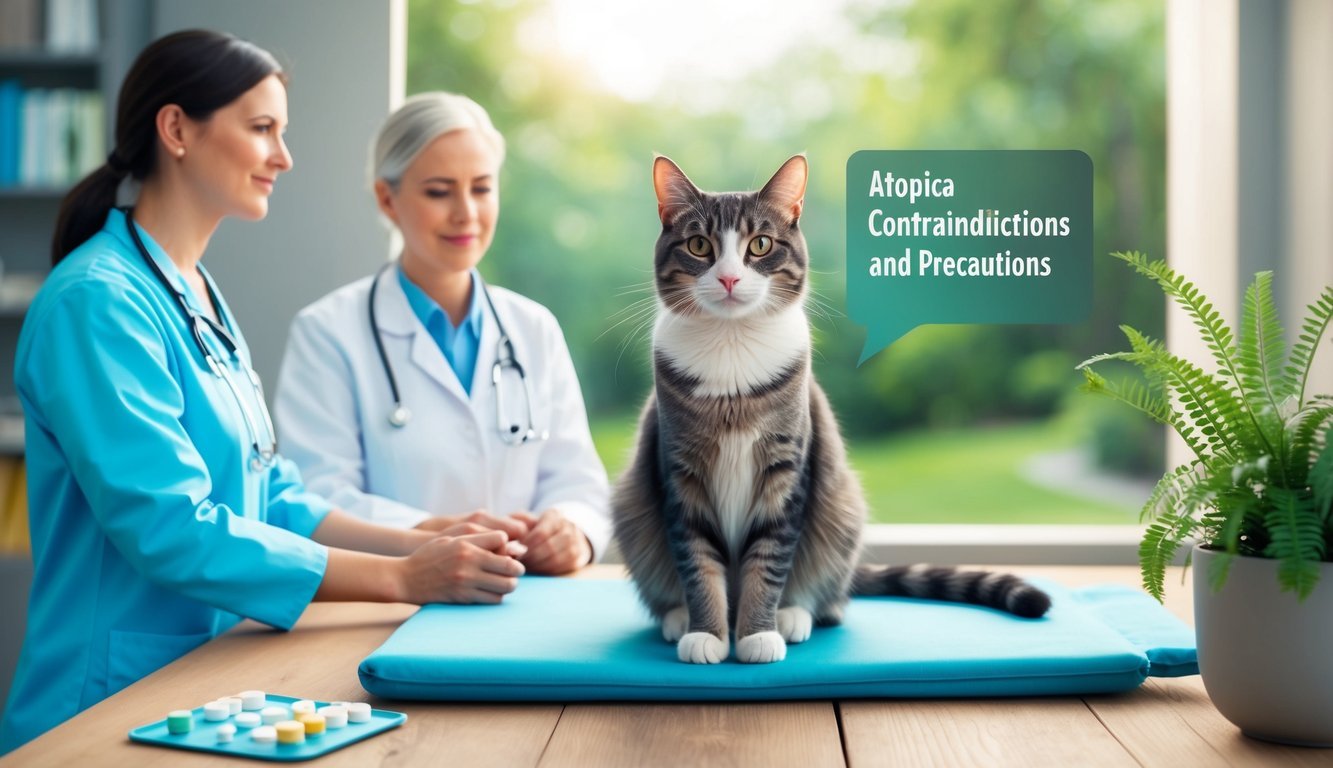Atopica for Cats is an effective solution for managing allergic dermatitis in felines.
This medication contains cyclosporine, which works as an immunosuppressant to reduce inflammation, itching, and other uncomfortable symptoms associated with various skin conditions.
Many cat owners find themselves seeking relief for their pets’ persistent scratching and skin issues, and Atopica offers a viable option to restore comfort and skin health.
Knowing how to administer Atopica correctly can be crucial for your cat’s well-being.
The oral liquid form is easy to give, but understanding the potential side effects and monitoring your cat during treatment is essential for ensuring a safe experience.
Your proactive approach can significantly impact your cat’s quality of life as they navigate the challenges of allergies.
Key Takeaways
- Atopica is a cyclosporine-based medication for allergic dermatitis in cats.
- Proper administration and monitoring are vital for safety and effectiveness.
- Awareness of side effects can help you manage your cat’s health better while on Atopica.
Understanding Atopica for Cats
Atopica for Cats is an important medication that helps manage allergic dermatitis in felines.
It contains a key ingredient that supports the immune system and can truly make a difference for your cat’s comfort.
What is Atopica
Atopica is an oral medication specifically designed for cats suffering from allergic dermatitis.
The solution is taken daily, making it easier for pet owners to administer.
It is particularly useful for cats that experience symptoms like itching, inflammation, and self-induced hair loss due to allergies.
This medication is intended for cats aged at least six months and weighing a minimum of three pounds.
By targeting the root cause of skin issues, Atopica helps restore a cat’s quality of life, allowing them to enjoy normal activities without discomfort.
The Active Ingredient: Cyclosporine
The active ingredient in Atopica is cyclosporine, an immunosuppressive agent.
This means it works by dampening your cat’s immune response, which is often overactive in cases of allergic dermatitis.
Cyclosporine is a cyclic polypeptide, consisting of 11 amino acids.
By modulating immune activity, it helps reduce inflammation and itching associated with allergic reactions.
It’s essential to follow your veterinarian’s dosage recommendations to ensure optimal results.
Commonly, the prescribed dosage is 7 mg per kilogram of body weight daily.
FDA-Approved Uses
Atopica is FDA-approved for treating allergic dermatitis in cats, specifically conditions that result in skin irritation and discomfort.
It is commonly recommended when other treatments have failed or are not suitable.
Conditions like miliary dermatitis, eosinophilic plaques, and self-induced alopecia are specifically addressed by this medication.
Monitoring your cat during treatment is crucial, as side effects may include loss of appetite, vomiting, and diarrhea.
Always consult your veterinarian to determine if Atopica is right for your cat’s specific situation.
Regular follow-ups can help gauge effectiveness and adjust the treatment plan as needed.
Health Conditions Treated with Atopica

Atopica is primarily used to manage specific health conditions in cats, particularly those related to allergies and skin disorders.
Understanding these conditions can help you make informed decisions regarding your cat’s treatment.
Allergic Dermatitis in Cats
Allergic dermatitis is a common issue affecting cats, resulting from their immune systems reacting to various allergens.
This condition manifests through various symptoms, including itching and inflammation.
Atopica is FDA-approved for controlling allergic dermatitis caused by environmental factors.
It works by suppressing the immune response, allowing your cat to find relief from discomfort.
Key symptoms include:
- Excoriations: Scratches or wounds from excessive itching.
- Self-Induced Alopecia: Hair loss due to constant licking or biting the affected area.
Proper diagnosis by a veterinarian is essential to determine if Atopica is the right treatment for your cat’s specific case of allergic dermatitis.
Other Skin Conditions
Besides allergic dermatitis, Atopica can also help manage several other skin conditions in cats.
This includes ailments like eosinophilic plaques and miliary dermatitis.
Eosinophilic plaques are raised lesions, often found on cats’ bellies or thighs, presenting as red, inflamed areas.
Miliary dermatitis, on the other hand, is characterized by tiny scabs and bumps on the skin, usually resulting from an allergic reaction.
Atopica’s formulation allows it to be effective for these off-label uses at the vet’s discretion.
Your veterinarian can guide you in assessing the suitability of Atopica based on your cat’s symptoms and overall health.
How to Administer Atopica
Administering Atopica to your cat requires attention to detail to ensure effective treatment.
It’s important to prepare the oral solution correctly and follow the dosing guidelines closely for optimal results.
Preparation of the Oral Solution
Before giving Atopica, check that you have the correct dosage for your cat’s weight.
The oral solution comes in a bottle, which may require shaking gently to ensure proper mixing.
Use the provided syringe or dropper for accurate measurement.
Make sure to administer the medicine during a time that aligns with your cat’s regular feeding schedule.
This helps improve absorption and minimizes any potential gastrointestinal upset.
If you have any concerns about the preparation process, don’t hesitate to consult your veterinarian.
Dosing Guidelines
The typical dosage of Atopica for cats is based on weight.
You should give 7 mg of Atopica per kg of your cat’s body weight each day.
For those using pounds, this equates to 3.2 mg per pound daily.
Once you’ve calculated the appropriate dose, dispense it using the syringe.
Ensure your cat consumes the full dose.
Skipping doses may reduce the effectiveness of the treatment.
If you are unsure about the correct dosage for your pet, your veterinarian can provide accurate recommendations.
Frequency of Administration
Atopica should be administered once daily for effectiveness.
Consistency is vital, so try to give the medication at the same time each day.
This helps to establish a routine, making it easier for both you and your cat.
If you accidentally miss a dose, give it as soon as you remember. Do not double the dose to compensate for the missed one.
If it’s close to the time for the next dose, skip the missed dose and resume your regular schedule.
Always consult your veterinarian if you have any questions about missed doses or administration frequency.
Potential Side Effects and Adverse Reactions

When considering Atopica for your cat, it’s crucial to be aware of the potential side effects and adverse reactions.
These can affect your pet’s overall well-being and comfort, so recognizing the signs early is essential.
Gastrointestinal Issues
Gastrointestinal side effects are among the most common when using Atopica.
You might notice your cat experiencing vomiting, diarrhea, or weight loss.
This can happen due to digestive upset often associated with the medication.
In some cases, your cat may show signs of anorexia, which is a decreased appetite.
If they seem lethargic or less active than usual, it’s vital to consult your veterinarian.
Severe digestive reactions can lead to conditions like hepatic lipidosis if not addressed promptly.
Keep an eye on your cat’s eating habits and stool quality to ensure they are adjusting well to the treatment.
Systemic Reactions
Systemic reactions can manifest when your cat’s immune system responds to Atopica.
You might observe hypersalivation, where your pet drools more than usual.
Other signs include muscle tremors and ataxia, which affects their coordination.
In rare instances, more severe reactions can occur such as convulsions or urinary tract issues.
If your cat exhibits any unusual behavior, such as increased anxiety or lethargy, it’s important to seek veterinary guidance immediately.
Quick intervention can make a significant difference in managing these side effects and ensuring your cat’s comfort.
Behavioral Changes
Atopica can also influence your cat’s behavior.
Some owners report changes in their pet’s temperament, which may include increased irritability or signs of behavioral disorders.
You may notice your cat becoming more withdrawn or anxious during treatment.
This could be a reaction to the medication itself, or a response to how they’re feeling physically.
Keeping a close watch on their behavior can help you determine if they are struggling.
Communicate any behavioral concerns to your veterinarian, as they can suggest ways to help your cat adjust to the treatment.
Contraindications and Precautions

It’s essential to be aware of specific contraindications and precautions when considering Atopica for your cat.
Certain health conditions and potential drug interactions can affect treatment safety.
Immunocompromised Cats
If your cat is immunocompromised, particularly with conditions like Feline Immunodeficiency Virus (FIV) or Feline Leukemia Virus (FeLV), using Atopica may pose risks.
These conditions can weaken the immune system, and Atopica, an immunosuppressive drug, may further increase vulnerability to infections.
Additionally, diabetic cats or those with renal insufficiency should be monitored closely, as these health issues can complicate treatment.
If your cat has a history of such conditions, consult your vet before administering Atopica to ensure it’s the best choice for their health.
Drug Interactions and Complications
When considering Atopica, it’s vital to be aware of potential drug interactions.
Cats with a known hypersensitivity to cyclosporine should avoid this medication altogether.
Some drugs may affect how cyclosporine works in your cat’s system or may increase the risk of side effects.
Be particularly cautious with any recent vaccinations, as the immune response might be compromised.
Always inform your veterinarian of any medications your cat is taking.
This helps to prevent complications and ensures the safest treatment plan for your furry friend.
Monitoring and Safety Information
When using Atopica for your cat, it’s crucial to understand the safety measures in place.
You’ll want to keep a close eye on their health and how they respond to the medication over time.
Clinical Safety Reviews
Clinical safety studies have assessed Atopica’s effects on cats.
In a six-week masked study, it was determined that the medication is generally well-tolerated.
However, there can be adverse reactions such as vomiting or diarrhea.
Your veterinarian will likely conduct follow-up assessments to monitor any changes in your cat’s condition.
It’s important to report any unusual behavior or symptoms you notice during treatment.
Make sure to discuss how your cat is responding with your veterinarian, especially during successive visits.
Regular evaluations help ensure that Atopica is achieving the desired effect while minimizing any risks.
Regular Health Assessments
Engaging in regular health assessments is vital while your cat is on Atopica.
You should schedule routine veterinary check-ups, especially within the first weeks of treatment.
This allows the vet to monitor your cat’s response, adjusting the dose as necessary.
During these visits, discuss any side effects you may have observed.
Your veterinarian may recommend blood tests to evaluate liver function and kidney health, as these can be impacted by long-term use of medication.
Maintaining a record of your cat’s condition can also help track improvements or adverse effects.
This proactive approach ensures your cat’s safety and comfort throughout the treatment.
Interaction with Immune Response
Atopica can suppress your cat’s immune response, affecting how they respond to vaccinations.
This is essential to consider, especially if your cat is due for vaccinations while undergoing treatment.
Naïve cats might not develop adequate protective titers during Atopica use.
Always inform your veterinarian about your cat’s vaccination history in relation to Atopica.
They may adjust vaccination schedules or recommend additional precautions to safeguard your cat’s health.
Being aware of this immune interaction allows you to make informed choices regarding your cat’s health plan.
Staying in communication with your veterinarian will help navigate these considerations effectively.
Understanding Immunosuppression in Cats

Immunosuppression plays a crucial role in managing various conditions in cats.
It helps regulate the immune response, particularly in cases where the immune system is overactive or mistakenly attacks the body.
Here, you’ll find insights into the role of immunosuppressants and the potential long-term impacts of their use.
Role of Immunosuppressants
Immunosuppressants, like cyclosporine (Atopica), are designed to suppress abnormal immune responses in your cat.
By inhibiting specific immune cell functions, these medications can relieve symptoms related to allergies and other immune-mediated disorders.
- Targeting Specific Cells: The drug primarily targets T-lymphocytes, reducing their activity. This is effective for conditions like allergic dermatitis.
- Systemic Action: As a systemic immunosuppressant, cyclosporine can work throughout your cat’s body, helping control widespread allergic reactions.
- Dosing and Administration: Typically administered as an oral solution, it’s essential to follow your vet’s dosage recommendations closely for the best results.
Long-Term Impacts
Long-term use of immunosuppressants requires careful monitoring.
While effective, these medications can alter your cat’s overall health.
- Increased Risk of Infections: With a suppressed immune system, your cat may become more susceptible to infections, including bacterial and viral diseases.
- Neoplasia Concerns: Prolonged immunosuppressive therapy might elevate the risk of neoplasia, which refers to abnormal tissue growth. Regular vet check-ups are essential to monitor for any signs of disease.
- Organ Health Monitoring: Your veterinarian may recommend routine blood tests to assess liver and kidney function, ensuring that the body continues to tolerate the medication effectively.
Supportive Care for Cats on Atopica
When your cat is on Atopica, providing supportive care is essential.
This can enhance the treatment’s effectiveness and help manage any side effects that may arise.
Here’s what you should focus on.
Nutritional Support
Nutrition plays a crucial role in your cat’s overall health, especially when undergoing treatment with Atopica.
A well-balanced diet can help prevent weight loss, which some cats may experience due to reduced appetite.
Consider the following tips:
- High-Quality Protein: Choose cat food rich in high-quality protein to support muscle maintenance.
- Hydration: Ensure your cat has constant access to fresh water. Increased thirst (polydipsia) can occur.
- Sensitive Diet: If your cat has allergies, look for hypoallergenic food options.
Regularly consult your veterinarian to adjust dietary needs based on your cat’s response to treatment.
Managing Side Effects
Atopica may bring about side effects, including itching, hair loss, or gastrointestinal issues.
Managing these can help keep your cat comfortable.
- Monitor for Itching: Keep an eye on any increase in itching or self-trauma. Regular grooming can help.
- Ocular Discharge and Sneezing: If you notice ocular discharge or sneezing, prompt veterinary attention is necessary. These symptoms may indicate complications.
- Gingivitis Concerns: Dental care can help manage gingivitis. Dental treats or regular brushing can mitigate this risk.
Don’t hesitate to discuss any observed side effects with your veterinarian for tailored advice.
Monitoring Progress
Keeping track of your cat’s progress while on Atopica can significantly influence treatment outcomes.
Regular monitoring helps in identifying efficacy or potential issues early.
- Weight Checks: Monitor your cat’s weight regularly. Weight loss can be a concern and may require dietary adjustments.
- Physical Changes: Observe for hair loss or changes in overall coat condition. This can indicate how well your cat is responding.
- Behavioral Shifts: Take note of any behavioral changes, such as lethargy or increased aggression. This can reflect discomfort or other side effects.
Schedule follow-up visits with your veterinarian to ensure your cat is on the right track throughout the treatment process.
Frequently Asked Questions
When considering Atopica for your cat, you might have some common questions regarding its use, side effects, dosing, and alternative treatments.
Here are some answers to help you make informed decisions.
What are the common side effects of using Atopica in felines?
Some common side effects of Atopica include loss of appetite, weight loss, vomiting, and diarrhea.
If your cat experiences any of these symptoms, it’s important to contact your veterinarian promptly.
How do you determine the right dose of Atopica for your cat?
The appropriate dose of Atopica varies based on your cat’s weight and specific health needs.
Your veterinarian will prescribe the correct dosage, typically administered daily with food to improve absorption.
What’s the average cost of Atopica for cats?
The cost of Atopica can vary significantly based on your location and the vet’s pricing.
Generally, you can expect to pay around $30 to $100 for a month’s supply, depending on the dosage prescribed.
How long is it typically safe for cats to be treated with Atopica?
Atopica can be used long-term for managing conditions like allergic dermatitis, but your veterinarian will monitor your cat’s health regularly.
Treatment duration largely depends on the individual response and any side effects observed.
Is Atopica considered a steroid medication for cats?
Atopica is not a steroid; it is an immunomodulator that works by selectively inhibiting certain components of the immune system.
This helps manage allergic reactions without the side effects commonly associated with steroids.
Are there any alternative treatments to Atopica for managing feline conditions?
Yes, alternatives to Atopica include other medications like corticosteroids and antihistamines.
Holistic options such as diet changes or environmental controls to reduce allergens are also available.
Always consult with your veterinarian to find the best treatment for your cat.

